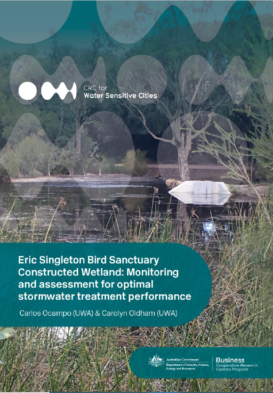Eric Singleton Constructed Wetland: Monitoring and assessment for optimal stormwater treatment performance
Context
This report presents findings from monitoring and assessment of the performance of the Eric Singleton Bird Sanctuary (ESBS) in Perth, Western Australia.
The ESBS is situated on the banks of the Swan River, and tidal flows and high estuarine water have been observed travelling up Bayswater Brook from the river (GHD 2013). The impact of estuarine flows on the wetland water balance before its reconfiguration was quantified, highlighting the role of the tide in explaining water level variability in the wetland (GHD 2013). However, the wetland hydraulic and nutrient attenuation performance after its reconfiguration has not previously been assessed.
The reconfiguration of the ESBS was completed in October in 2015 and involved partial diversion of water from Bayswater Brook (< 200 L/s, GHD 2013) to a gross pollutant trap (GPT), installed at the inflow of the wetland. Brook water flowed out of the GPT into a sedimentation pond, then a marsh wetland, and finally out to the Bayswater Brook again, before being discharged to the Swan River. This treatment train system was predicted to remove up to 40 tonnes of sediment and rubbish per year, approximately 200 kg of phosphorus per year and 1.3 tonnes of nitrogen per year (GHD 2013), however the actual nutrient attenuation performance of the ESBS has not previously been assessed.
For this project, baseflow performance was determined during 2017 to 2019.
Rainfall event runoff was also intensively monitored and sampled from June to August 2019; a total of 382 mm was recorded over the 3-month period. Over this period, five storm events were monitored: one small (less than 10 mm), two minors (less than 40 mm) and two majors. Event 5 on 16 August comprised the 1-year ARI event, and was particularly important for analysing the wetland’s hydraulic response and nutrient attenuation capacity.
